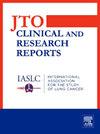Incorporating High-Risk Individuals Beyond Smoking History Into Lung Cancer Screening in Hong Kong: A Cost-Effectiveness Study
IF 3.5
Q2 ONCOLOGY
引用次数: 0
Abstract
Introduction
Lung cancer (LC) accounts for 26.4% of all cancer deaths in Hong Kong (HK). Lung cancer screening (LCS) with low-dose computed tomography (LDCT) can reduce LC mortality. The cost-effectiveness of LDCT screening in high-risk individuals on the basis of smoking history has previously been investigated. However, nearly half of patients with LC in HK never smoke, indicating a different LC epidemiology compared with Western countries, where most LC cases are associated with smoking. We conducted a cost-effectiveness analysis for LCS, utilizing local data and expanding the target population to include we not only high-risk individuals identified on the basis of smoking history but also those identified through other risk factors.
Methods
A decision tree combined with a state-transition Markov model was developed to simulate identification, diagnosis, and treatments for high-risk individuals, from a health care provider perspective. The selection criteria and screening effectiveness for high-risk individuals on the basis of smoking history were obtained from the Dutch-Belgian Lung Cancer Screening Study, targeting heavy smokers aged 50 to 74 years; whereas the Taiwan Lung Cancer Screening in Never-Smoker Trial was used to model high-risk individuals on the basis of factors other than smoking history. Local LC survival and cost data were used to populate the model. The willingness-to-pay threshold used in the study was US$24,302 to US$40,202 per quality-adjusted life-year (QALY).
Results
Screening led to additional early LC detected, and LC mortality reduction, compared with no screening. Over a lifetime horizon, the incremental cost-effectiveness ratio for high-risk individuals on the basis of smoking history was US$14,122 per QALY. The incremental cost-effectiveness ratio for high-risk individuals on the basis of factors other than smoking history was lower at US$9610 per QALY.
Conclusion
LCS with LDCT can be considered cost-effective in HK for high-risk individuals on the basis of smoking history and factors other than smoking history, contributing to the health benefits of the population. Our findings support a population-based LCS for all high-risk individuals identified through criteria beyond smoking history.
将吸烟史以外的高危人群纳入香港肺癌筛查:成本效益研究
在香港,肺癌(LC)占所有癌症死亡人数的26.4%。肺癌筛查(LCS)与低剂量计算机断层扫描(LDCT)可以降低肺癌死亡率。基于吸烟史对高危人群进行LDCT筛查的成本-效果已经进行了调查。然而,香港近一半的LC患者从不吸烟,这表明与西方国家的LC流行病学不同,大多数LC病例与吸烟有关。我们对LCS进行了成本效益分析,利用当地数据并扩大目标人群,不仅包括根据吸烟史确定的高危人群,还包括通过其他风险因素确定的高危人群。方法从医疗服务提供者的角度,建立一种结合状态转移马尔可夫模型的决策树来模拟高风险个体的识别、诊断和治疗。基于吸烟史的高危人群的选择标准和筛查效果来自荷兰-比利时肺癌筛查研究,目标人群为50 - 74岁的重度吸烟者;而台湾不吸烟者肺癌筛查试验则是根据吸烟史以外的因素对高危人群进行建模。使用局部LC生存和成本数据填充模型。研究中使用的支付意愿阈值为每个质量调整生命年(QALY) 24,302美元至40,202美元。结果与未筛查相比,筛查可导致更多的早期LC检测,并且LC死亡率降低。在整个生命周期中,基于吸烟史的高风险个体的增量成本-效果比为每QALY 14122美元。基于吸烟史以外因素的高风险个体的增量成本-效果比较低,为每QALY 9610美元。结论基于吸烟史和吸烟史以外的因素,lcs联合LDCT可被认为是香港高危人群具有成本效益的,有助于人群的健康益处。我们的研究结果支持通过吸烟史以外的标准确定的所有高风险个体的基于人群的LCS。
本文章由计算机程序翻译,如有差异,请以英文原文为准。
求助全文
约1分钟内获得全文
求助全文
来源期刊

JTO Clinical and Research Reports
Medicine-Oncology
CiteScore
4.20
自引率
0.00%
发文量
145
审稿时长
19 weeks
 求助内容:
求助内容: 应助结果提醒方式:
应助结果提醒方式:


